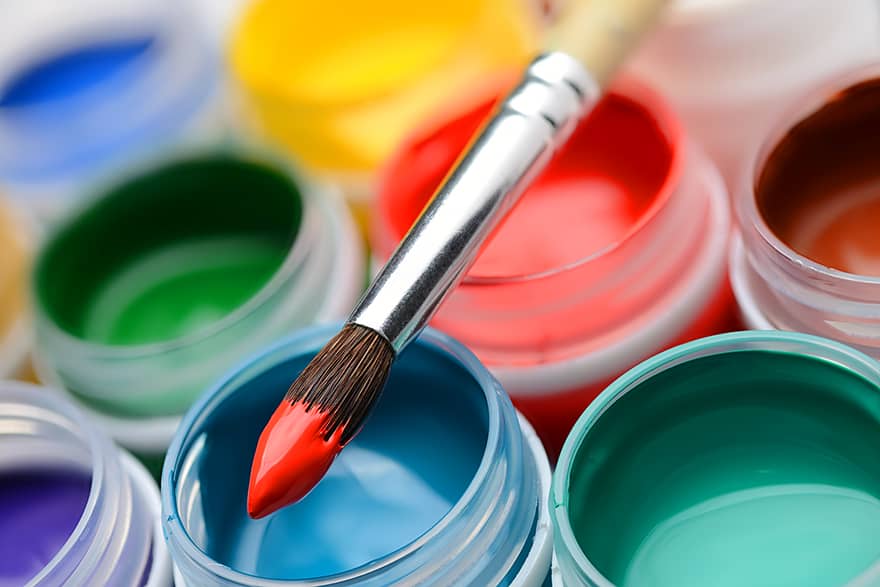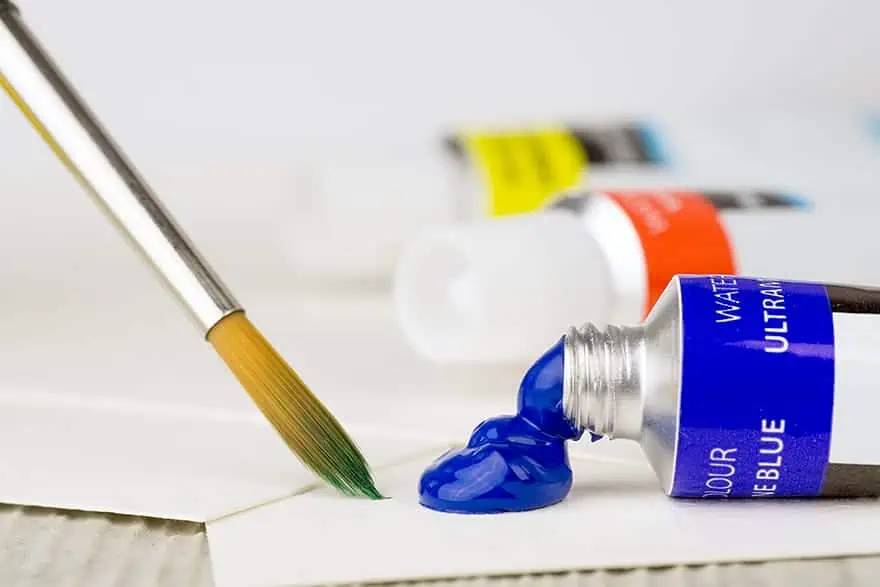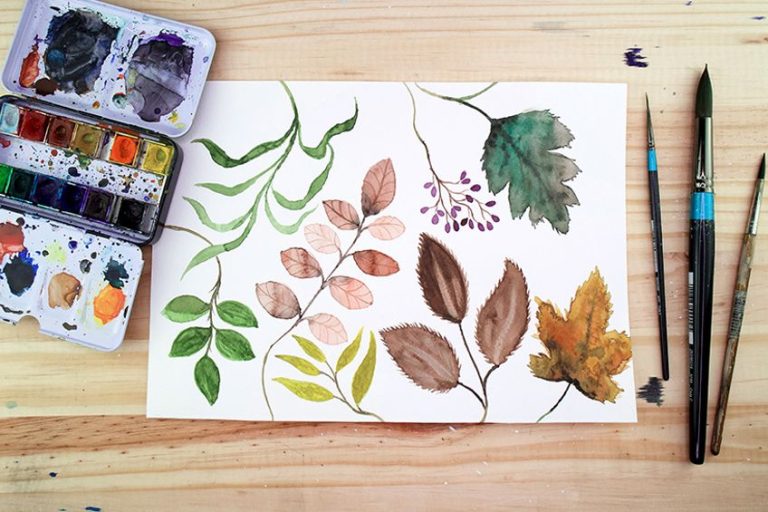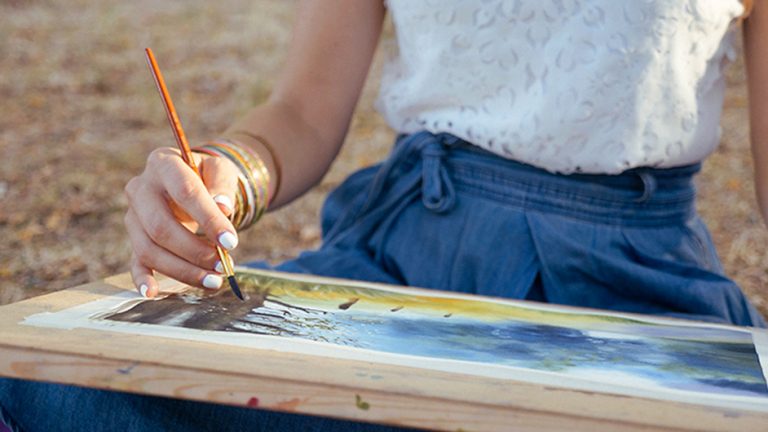Is Acrylic Paint Toxic? – All about Acrylic Paint Toxins
This post may contain affiliate links. We may earn a small commission from purchases made through them, at no additional cost to you.
Many DIY artists are fully aware of what they can produce with their paints, such as various colors, patterns, different effects they can create, and so on, however, not many of them are aware of acrylic paint ingredients. There are watercolors, oils, and acrylic paints, some of them contain harmful toxic chemicals that can damage your body as well as the environment. So, how do we go about becoming more aware of some of these risks, and can we prevent them from harming us. In this article we will be dealing with acrylic paints and answering this question for you; is acrylic paint toxic?
Table of Contents
How Toxic is Acrylic Paint?
Many people love painting as a hobby and kids always love to paint, but questions always arise about the toxicity of the paint especially if it is being used by young children. It is safe to say that non toxic acrylic paint is water-based, and can easily be cleaned using soap and water. When using acrylic paints while airbrushing they can become toxic as fine particles are released into the air, so you should spray in a well-ventilated space as you do not want to breathe these particles in. When you sand the surface, after applying the acrylic paint, it can also be toxic if the particles are inhaled, or if you swallow a large amount of paint.
If you purchase an acrylic paint that has additives like pigments or colors then they could be toxic, as these additives all contain chemicals such as lead, cobalt, chromium, cadmium, and manganese. Therefore, you should check the manufactures instructions on the labels when buying your paint. So, is acrylic paint toxic? In general, if you are using acrylic paints for painting purposes only and applying them with a brush onto a canvas or paper, the acrylic paint should not be harmful to your health. If you tend to use your fingers often when painting, you may want to consider using gloves.

Points to Consider When Using Acrylic Paints
When you are working with acrylic paints it is recommended you keep in mind your own safety as well as the safety of the environment.
Be Aware of the Acrylic Paint Ingredients
Oil paints contain vegetable oils with added mediums and solvents that make them toxic and harmful to your health and the environment. Acrylic paints, on the other hand, have the same pigments as oil paints but they contain acrylic polymer emulsions, and their binder is an acrylic polymer. This means that when they start to dry the acrylic polymers release ammonia, water, and propylene glycol into the air which makes it perfectly safe for use. However, some products may contain hazardous materials like heavy metals, so checking out the label is always a good idea.
Acrylic Paint Toxins
The American Society for Testing Materials (ASTM) has a warning on the label indicating if it is safe and free from any acrylic paint toxins. On the same label, it gives you instructions of safe ways to use the paint, like spraying, and if swallowed or inhaled what to do. The manufactures website should also have information on such things as the effects added pigments will have on your health as well as the environment. Acrylic paint labelled non-toxic is safe to use. However, propylene glycol is released into the air when the acrylic paint dries, and this can be harmful to the environment. This substance is safe for us as humans to use, but it is very harmful to the environment, and as such must not be thrown down the drain when disposing of it.

Keep Your Workplace Safe
Sometimes we are so wrapped up in trying to abide by all the safety precautions regarding our paint that we seem to forget that our workspace is just as important. When acrylic and oil paints start to dry, they release harmful chemicals or particles into the air which makes ventilation important. If you are working on a small project, then just opening a window should be enough. However, if your project is fairly large and you are working on it daily, then a ventilation system might be a good idea. One general or common workspace rule is to not bring drink or food into your work area. Sometimes this is not very practical as many of us love to have that cup or two of coffee during the day. If this is you, no problem, just be careful how you handle your cup and take it by the ear and not the rim of the cup, as you never know what is on your hands. Also, washing your hands regularly is advisable.
Sanding a painted surface or if you are spraying the paint, you should avoid doing this in a confined space and preferably do it outdoors. You should also use protective equipment when doing these types of jobs to avoid breathing in any paint or dust. If your acrylic paint contains dangerous pigments, there are always alternative products available that are usually much cheaper. Most of the paint manufacturers will provide you with an alternative and safer product. These can easily be found, as they will have no warning labels.
Disposing of Acrylic Paint
When you paint you can generate a great deal of waste like rags, paper towels as well as certain pigments that are suspended in water. So, when disposing of these items it is important to do it correctly, to keep you and the environment safe. Never pour the pigment paint sludge down the drain, as this will cause problems when it flows into the water system. Simply decant the paint sludge into a container that you can seal and drop it off at a chemical disposal site. Many municipalities will arrange to collect larger amounts from you, and they will dispose of it correctly.
Contaminated rags can simply go into a garbage bag as long as it is clearly labeled ‘paint rags that contain cadmium’. You can also drop them off together with your paint sludge at the disposable depot. So, when working with acrylic or any other paint product try to comply with the safety precautions concerning the paint product and your workplace. This will guarantee your safety and protect the environment.
Is Acrylic Paint Safe for Kids?
Is acrylic paint toxic? This question does not only pertain to adults but children as well. Kids love painting but you want to make sure they are safe while having fun. Is acrylic paint safe for kids? Non toxic Acrylic paint is safe for your kids but we still recommend that they are supervised by an adult when using acrylic paints. The kids just love this type of paint as there are many vibrant colors and it is so easy to mix and clean.

Some Safety Tips for Children to Observe
Acrylic paints are not harmful to kids as it is water-based. However, you need to emphasize that the paint is meant for the canvas or paper only and nowhere else.
- When painting with acrylic paint for kids make sure they wear gloves
- The gloves need to have a breathable back
- We recommend nitrile gloves as they prevent toxins from getting to your skin
- When you purchase your acrylic paint make sure it is non toxic acrylic paint
If you are still in doubt and not sure if acrylic paint for kids is safe, especially for smaller kids, there are other options for you to consider:
Tempera Paint: This type of paint is great for smaller kids as it dries fast, will not flake or crack, and is quite easy to clean up. It is available in a gloss and matte finish and can be applied to wood, cardboard, canvas, or paper surfaces. The paint comes in a liquid and powder form. Do not mix the powder around the kids as the dust particles if inhaled, can be harmful.
Activity Paint: This type of paint has been specially designed for small children. The paint is water-based and comes in a gel form. This type of paint adheres easily to different surfaces and is also easy to clean up.
Watercolor Paints: These paints come in many bright colors, but you will need thick paper or board to paint on as it requires a maximum absorption surface.
Finger Paints: This paint has been specially designed for small children and works best on thicker paper and is also easy to remove from the skin. When buying this type of paint, it is best to go for a creamy formulation, as this reduces the amount of splashing.
No matter what type of paint you want to buy your children, make sure it is non-toxic and carries the AP (Approves Product) seal. This means that the paint has been approved by medical experts not to contain substances that will be harmful to your children or cause serious health problems. If you find your paint tin contains this code ‘ASTM D-4236’ then you are assured that it carries the approval of the American Society for Testing Materials.

How Toxic is Acrylic Paint When Swallowed?
Remember, if a product is labeled as non-toxic, it does not mean that it is safe to consume. So, if acrylic paint for kids is consumed in large amounts it can be toxic and may cause serious health problems. This is why smaller children should be supervised when using acrylic paints, as their natural tendency is to put fingers in their mouths. In most cases, it is recommended that acrylic paints not be used by any child under the age of 3 years. When you find your child with paint all around the mouth, the first thing to do is not to panic. After figuring out the amount of paint consumed, if it is only a small amount there is no cause for alarm. Wash the excess paint off their mouths, get them to brush their teeth and drink a lot of water, even let them gargle with some saltwater.
If you notice some allergic reactions occurring, just monitor the child for a few hours and allow the paint to pass through their system. However, if they have consumed a large quantity of paint or if it gets into their eyes contact your local doctor or poison control immediately.
Are Pets Affected by Acrylic Paint?
Pets, especially cats, are very curious animals and they may lick the newly painted surface, or even drink some of the diluted paint. Acrylic paint is not toxic to your pets, as it is water-based and the small amounts they may ingest should only result in mild irritation to their mucous membranes and skin. However, if your pet has ingested a large amount of acrylic paint, they could develop some of the symptoms below within a few hours. If you observe some of the below symptoms contact your veterinarian immediately.
- Diarrhea
- Lethargy
- Vomiting
- Difficulty in walking or standing
- Difficulty in breathing
- Tremors
In most cases using non toxic acrylic paint is safe to use around your pets, it is just a matter of making sure you do not leave paint lying around and to store them properly.

Frequently Asked Questions
Are Acrylic Paints Toxic?
If you use acrylic paints solely for art and creative painting it should not be a problem, as they are water-based. The problem comes when the paint is applied using an airbrush, when you sand the painted surface down, or when you drink large amounts of it.
Are Acrylic Paints Flammable?
Acrylic paints do not contain any flammable chemicals and you can clean your brushes with soap and water.

Can Acrylic Paint cause Cancer?
Acrylic paints that are marked as non-toxic will not give you cancer. However, some acrylic paints contain some harmful heavy metals like cadmium, chromium, and cobalt, these types of paints have been labeled as hazardous and harmful. Therefore, it is vital when buying your paint that you check the label and ensure you are buying non-toxic paint.
Is Acrylic Paint Harmful when Swallowed?
Not if swallowed in small quantities. If you accidentally swallow some paint just wash your mouth out and drink lots of water.
When you heat acrylic paint is it toxic?
Yes, when thermo-plastics are heated, they can emit some harmful gasses at a certain temperature that may be toxic.
Can I Use Acrylic Paint on my Childs Face?
Even though acrylic paints are non-toxic, it is not recommended you paint directly onto the skin as some of the pigments can be toxic. If the acrylic paint does get onto the skin, it could cause irritation. Acrylic paints are not intended for this purpose, there are special face paints you can use.
In 2005, Charlene completed her wellness degrees in therapeutic aromatherapy and reflexology at the International School of Reflexology and Meridian Therapy. She worked for a company offering corporate wellness programs for several years before opening her own therapy practice. In 2015, she was asked by a digital marketer friend to join her company as a content creator, and it was here that she discovered her enthusiasm for writing. Since entering the world of content creation, she has gained a lot of experience over the years writing about various topics such as beauty, health, wellness, travel, crafting, and much more. Due to various circumstances, she had to give up her therapy practice and now works as a freelance writer. Since she is a very creative person and as a balance to writing likes to be active in various areas of art and crafts, the activity at acrylgiessen.com is perfect for her to contribute their knowledge and experience in various creative topics.
Learn more about Charlene Lewis and about us.







